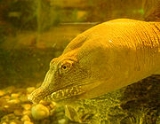
Chinese Soft-shelled Turtle
Encyclopedia
The Chinese softshell turtle (Pelodiscus sinensis), formerly known as Trionyx sinensis, was described by Wiegmann in 1835. The species is also referred to as the Asiatic Soft Shelled Turtle.
There is a subspecies japonicus which is sometimes erroneously listed as Pelodiscus japonica.
It is difficult to determine its native range due to the long tradition of use as a food and "tonic" and subsequent spread by migrating people. The Chinese soft-shelled turtle has been introduced to Malaysia, Singapore, Thailand, Timor, Batan Islands, Guam, some of the Hawaiian Islands California and Virginia.
684 Chinese turtle farms, they sold over 91 million turtles of this species every year; considering that these farms represented less than half of the 1,499 registered turtle farms in China, the nationwide total could be over twice as high.
These turtles can be injured if they are dropped or hit, and are susceptible to shell fungus. Within Europe, the turtle is a popular pet, particularly in countries such as Italy and the Czech Republic.
There is a subspecies japonicus which is sometimes erroneously listed as Pelodiscus japonica.
Appearance
The Chinese softshell turtle can reach a carapace length of 1 foot (30.3 cm). It has webbed feet for swimming.Habitat
With its long snout and tubelike nostrils, the Chinese soft-shelled turtle can "snorkel" in shallow water. When resting, it lies at the bottom, buried in sand or mud, lifting its head to breathe or snatch at prey.Distribution
The Chinese softshell turtle is found in China (including Manchuria and Taiwan), Korea, North Vietnam and Japan, and Russia.It is difficult to determine its native range due to the long tradition of use as a food and "tonic" and subsequent spread by migrating people. The Chinese soft-shelled turtle has been introduced to Malaysia, Singapore, Thailand, Timor, Batan Islands, Guam, some of the Hawaiian Islands California and Virginia.
Animal Husbandry
The Chinese Softshell Turtle (Pelodiscus sinensis) is the turtle species raised on China's turtle farms. According to the data obtained from684 Chinese turtle farms, they sold over 91 million turtles of this species every year; considering that these farms represented less than half of the 1,499 registered turtle farms in China, the nationwide total could be over twice as high.
These turtles can be injured if they are dropped or hit, and are susceptible to shell fungus. Within Europe, the turtle is a popular pet, particularly in countries such as Italy and the Czech Republic.

